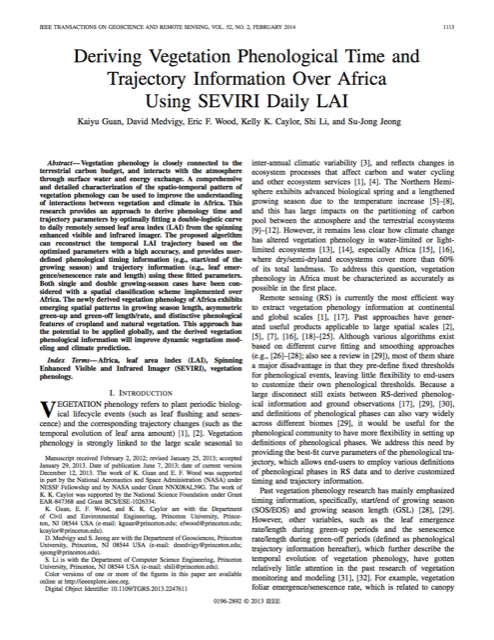Deriving Vegetation Phenological Time and Trajectory Information Over Africa Using SEVIRI Daily LAI

Guan, K., Medvigy, D., Wood, E.F., Caylor, K.K., Li, S., Jeong, S. (2014) “Deriving vegetation phe- nological time and trajectory information over Africa using SEVIRI daily LAI”, IEEE Transactions on Geoscience and Remote Sensing, doi:10.1109/TGRS.2013.2247611.
Vegetation phenology is closely connected to the terrestrial carbon budget, and interacts with the atmosphere through surface water and energy exchange. A comprehensive and detailed characterization of the spatio-temporal pattern of vegetation phenology can be used to improve the understanding of interactions between vegetation and climate in Africa. This research provides an approach to derive phenology time and trajectory parameters by optimally fitting a double-logistic curve to daily remotely sensed leaf area index (LAI) from the spinning enhanced visible and infrared imager. The proposed algorithm can reconstruct the temporal LAI trajectory based on the optimized parameters with a high accuracy, and provides user-defined phenological timing information (e.g., start/end of the growing season) and trajectory information (e.g., leaf emergence/senescence rate and length) using these fitted parameters. Both single and double growing-season cases have been considered with a spatial classification scheme implemented over Africa. The newly derived vegetation phenology of Africa exhibits emerging spatial patterns in growing season length, asymmetric green-up and green-off length/rate, and distinctive phenological features of cropland and natural vegetation. This approach has the potential to be applied globally, and the derived vegetation phenological information will improve dynamic vegetation modeling and climate prediction.
